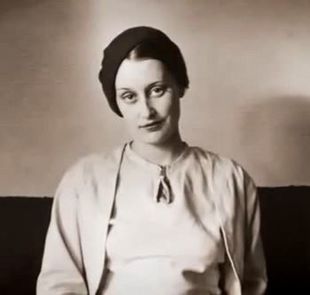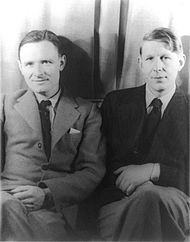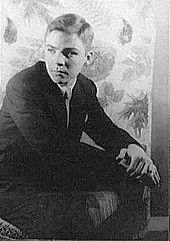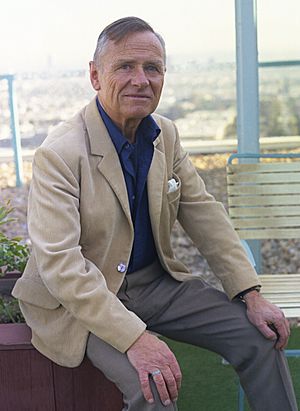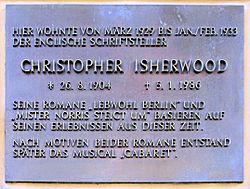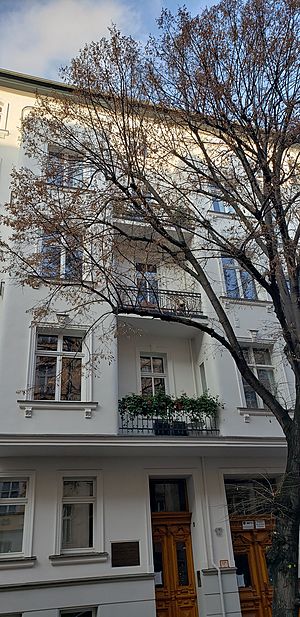Christopher Isherwood facts for kids
Quick facts for kids
Christopher Isherwood
|
|
|---|---|

Christopher Isherwood in 1938
|
|
| Born | Christopher William Bradshaw Isherwood 26 August 1904 High Lane, Cheshire, England |
| Died | 4 January 1986 (aged 81) Santa Monica, California, U.S. |
| Occupation | Novelist |
| Citizenship | British (1904–1946) American (1946–1986) |
| Alma mater | Corpus Christi College, Cambridge King's College London |
| Genre | Modernism |
| Notable works |
|
| Partner | Heinz Neddermeyer (1932–1937) Don Bachardy (1953–1986) |
| Signature | |
Christopher William Bradshaw Isherwood (born August 26, 1904 – died January 4, 1986) was a famous writer. He was a novelist, wrote plays, screenplays for movies, and kept diaries. He was born in England but later became an American citizen.
Some of his most well-known books include Goodbye to Berlin (1939), which inspired the musical Cabaret. Another important novel is A Single Man (1964), which was later made into a film. His memoir, Christopher and His Kind (1976), was also very influential.
Contents
About Christopher Isherwood
His Early Life and First Books
Christopher Isherwood was born in 1904 in Cheshire, England. He was the older son of Frank Isherwood, a soldier, and Kathleen Isherwood. His father fought in the Boer War and was killed during the First World War. Christopher's mother was related to the wealthy Greene brewing family. This meant he was a cousin of the well-known novelist Graham Greene.
Christopher went to a boarding school called Repton School. There, he met his lifelong friend Edward Upward. Together, they made up an imaginary English village called Mortmere. Christopher later wrote about this in his book Lions and Shadows (1938).
He went to Corpus Christi College, Cambridge to study history. However, he left in 1925 without finishing his degree.
After leaving Cambridge, Christopher worked as a private tutor. He also worked as a secretary for a music group. During this time, he finished his first novel, All the Conspirators, published in 1928. This book was about young people trying to become independent from their parents. In 1928, he also started studying medicine at King's College London, but he left after six months.
In 1925, he met W. H. Auden again, a friend from prep school. Through Auden, Christopher met another poet, Stephen Spender. These friends, along with Edward Upward, became known as an exciting new group of writers in England in the 1930s.
In March 1929, Christopher visited Auden in Berlin, Germany. This short trip changed his life. He enjoyed the city and decided to move there in November of that year.
Living in Berlin
While living in Berlin, Christopher finished his second novel, The Memorial (1932). This book explored how the First World War affected his family. He also kept a detailed diary. His diary notes helped him write Mr. Norris Changes Trains (1935) and Goodbye to Berlin (1939).
Goodbye to Berlin showed what the city was like as Adolf Hitler and the Nazis were gaining power. There was a lot of poverty and attacks on certain groups of people. But at the same time, the nightlife in the city's cafés and bars was still lively. This book included his 1937 story Sally Bowles, which featured his most famous character. Sally Bowles was based on a young Englishwoman named Jean Ross, with whom he once shared an apartment.
In America, his Berlin novels were put together and published as The Berlin Stories in 1945. Later, in 1951, Goodbye to Berlin was turned into a play called I Am a Camera. This play then inspired the very popular Broadway musical Cabaret (1966), which was also made into a film in 1972.
In 1932, Christopher began traveling with a young German friend, Heinz Neddermeyer. They left Nazi Germany in May 1933 because of the dangers there. They traveled to places like Greece, the Canary Islands, and Copenhagen. They were looking for a country where Heinz could live safely. In 1937, Heinz was arrested by the Gestapo, the Nazi secret police.
During this time, Christopher often returned to London. He started working on movie scripts. He also worked with Auden on three plays: The Dog Beneath the Skin (1935), The Ascent of F6 (1936), and On the Frontier (1938).
In 1938, Christopher and Auden traveled to China. They wrote a book called Journey to a War (1939) about the conflict between China and Japan. They returned to England through the United States and decided to move to America in January 1939.
Life in the United States
Christopher settled in Hollywood, California. He became friends with Truman Capote, a rising young writer. Capote was influenced by Christopher's Berlin Stories. Christopher also became friends with Dodie Smith, another British writer who had moved to California.
In 1946, Christopher became an American citizen. He had to promise to defend the country. He explained that he would help in non-fighting roles, like loading ships with food.
He also lived with photographer William "Bill" Caskey for a time. In 1947, they traveled to South America. Christopher wrote about their journey, and Caskey took the pictures for their 1949 book, The Condor and the Cows.
On Valentine's Day in 1953, when Christopher was 48, he met Don Bachardy. Don was 18 at the time. Despite their age difference, they became partners and stayed together for the rest of Christopher's life.
Christopher finished his novel The World in the Evening (1954) during the early months of their time together. Don helped him by typing the manuscript. Christopher also taught modern English literature at a college in Los Angeles for several years.
In 1962, he published Down There on a Visit. Many people believe his best book was A Single Man, published in 1964. This novel tells the story of one day in the life of George, an English professor in Los Angeles. The book was made into a film in 2009. In 1964, Christopher also worked on the screenplay for the film The Loved One.
Christopher Isherwood and Don Bachardy lived together in Santa Monica until Christopher's death. Christopher was diagnosed with prostate cancer in 1981. He died from the disease on January 4, 1986, at age 81. His body was given to medical science. Don Bachardy became a successful artist, and his portraits of Christopher during his final illness are well known.
His Interest in Vedanta
Christopher Isherwood became very interested in Vedanta. This is a philosophy from India that focuses on spiritual wisdom. His friends Gerald Heard and Aldous Huxley introduced him to the Vedanta Society of Southern California. This society was led by Swami Prabhavananda, a monk from India. Christopher became a dedicated follower of Vedanta and a close friend of the Swami.
His interest in Vedanta was so strong that he didn't write any novels between 1939 and 1945. Instead, he spent his time studying Vedanta scriptures. He even lived as a monk at the Society for a while. For 35 years, Christopher worked with the Swami to translate different Vedanta scriptures. These included the Bhagavad Gita – The Song of God. He also wrote articles for the Society's journal and sometimes gave talks.
From 1950 to 1978, Christopher gave 53 lectures at the Vedanta Temples. He often read papers written by others, like Swami Vivekananda. He also gave some original lectures, such as "Who Is Ramakrishna" and "The Writer and Vedanta."
Christopher was also very involved with the journal Vedanta and the West. He was the Managing Editor from 1943 to 1945. He also wrote 40 articles for the journal between 1949 and 1969.
Legacy and Recognition
- The house in Berlin where Christopher Isherwood lived has a special plaque. It marks his time there from 1929 to 1933.
- The 2008 film Chris & Don: A Love Story tells the story of Christopher Isherwood and Don Bachardy's long relationship.
- His novel A Single Man was made into a film in 2009.
- In 2010, his autobiography, Christopher and His Kind, was made into a TV film by the BBC. Matt Smith played Christopher Isherwood in the film.
- The Los Angeles Times started a special award in 2016. It's called the Christopher Isherwood Prize for Autobiographical Prose.
His Works
- All the Conspirators (1928)
- The Memorial (1932)
- Mr Norris Changes Trains (1935)
- The Dog Beneath the Skin (1935, with W. H. Auden)
- The Ascent of F6 (1937, with W. H. Auden)
- Sally Bowles (1937)
- On the Frontier (1938, with W. H. Auden)
- Lions and Shadows (1938, a fictional autobiography)
- Goodbye to Berlin (1939)
- Journey to a War (1939, with W. H. Auden)
- Bhagavad Gita, The Song of God (1944, with Prabhavananda)
- Vedanta for the Western World (1945, edited by Isherwood)
- Prater Violet (1945)
- The Berlin Stories (1945, combines Mr Norris Changes Trains and Goodbye to Berlin)
- The Condor and the Cows (1949, a travel diary)
- The World in the Evening (1954)
- Down There on a Visit (1962)
- A Single Man (1964)
- Ramakrishna and His Disciples (1965)
- Exhumations (1966, a collection of stories and articles)
- A Meeting by the River (1967)
- Kathleen and Frank (1971, about his parents)
- Frankenstein: The True Story (1973, with Don Bachardy)
- Christopher and His Kind (1976, autobiography)
- My Guru and His Disciple (1980)
- October (1980, with Don Bachardy)
- The Mortmere Stories (with Edward Upward) (1994)
- Diaries: 1939–1960 (1996)
- Jacob's Hands: A Fable (1997, with Aldous Huxley)
- Lost Years: A Memoir 1945–1951 (2000)
- The Sixties: Diaries:1960–1969 (2010)
- Liberation: Diaries:1970–1983 (2012)
Translations
- Charles Baudelaire, Intimate Journals (1930)
- The Song of God: Bhagavad-Gita (with Swami Prabhavananda, 1944)
- Shankara's Crest-Jewel of Discrimination (with Swami Prabhavananda, 1947)
- How to Know God: The Yoga Aphorisms of Patanjali (with Swami Prabhavananda, 1953)
Articles in Vedanta and the West
Vedanta and the West was a journal published by the Vedanta Society of Southern California. Christopher Isherwood wrote many articles for it.
|
|
In 1945, many of these articles were put together in a book called Vedanta for the Western World. Christopher Isherwood edited the book and wrote the introduction.
Images for kids
See also
 In Spanish: Christopher Isherwood para niños
In Spanish: Christopher Isherwood para niños



